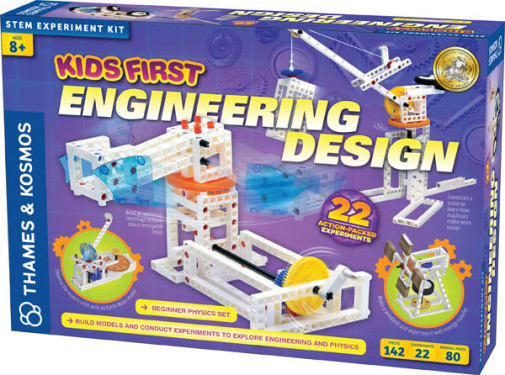We use cookies to make your experience better. To comply with the new e-Privacy directive, we need to ask for your consent to set the cookies. Learn more.
Engineering Design (Kids First Level 3)
- Small parts. Not for children under 3 years.
"Speed, power, catapults, and collisions! Physics is full of action! Kids will have the 20 models in this introductory physics kit racing, rolling, flying, falling, crashing, balancing, and spinning around in 22 action-packed science experiments. After following step-by-step illustrated instructions to build each model, kids test the models to demonstrate and comprehend basic laws of mechanical physics. While building the models and reading through the manual, young researchers learn about various topics in the fascinating world of mechanical physics and engineering.
Start your physics adventures by building a balancing tightrope walker, a moving elevator, and a high-g astronaut training centrifuge to learn about forces, gravity, and weight. Learn how to measure forces by building a force meter. Examine physics at the construction site to learn about work and simple machines. Build a pulley system, crane, and inclined plane to lighten the load and make work easier. Experiment with storing energy and converting energy by constructing models of a rocket car and a skee-ball mini golf ramp. Assemble three machines from the Middle Ages a wheelbarrow, a balance scale, and a trebuchet to learn how levers have helped people do work for centuries. Explore the concept of trajectory.
Continue your lessons by building a windmill, a drop-test device, and various parachutes to investigate the forces of air and air resistance. Expand your perspective out into the solar system to discover the force and motion of the planets and the sun. Build a sundial and a rotating Earth-and-Moon model. Take a crash course in applied physics with a series of automotive models and experiments: Construct a crash-test simulator and an airbag testing station to learn about momentum. Assemble a working gear train to learn how gears transmit and alter forces. Finally, make an all-wheel drive vehicle with a flexible jointed design for optimal performance on rough terrain."
This great new series is for your youngest engineers and scientists. Level 1 is for ages 3 to 5, and level 2 is for 5 to 7. This is a brand new line for Thames and Kosmos and is intended to introduce young learners to science and math concepts while also developing fine motor skills and visual/spatial reasoning. At level 1, the building is accompanied by an engaging storybook (24 pages in length), pretend play, and simple activities. The activities reflect the content of the story line and use chunkier building pieces that are great for smaller hands. Each kit comes nicely packaged in a durable storage container.
Level 2 takes children to the next level of science there are no storybooks, but a detailed 48-page, illustrated guide book comes in every kit. These kits introduce children to the scientific method and teach science basics using hands-on experiments. Level 2 kits do not have a storage container.
| Product Format: | Other |
|---|---|
| Brand: | Thames and Kosmos |
| Grades: | 3-7 |
| EAN/UPC: | 814743011441 |
| Length in Inches: | 11.625 |
| Width in Inches: | 16.75 |
| Height in Inches: | 3.25 |
| Weight in Pounds: | 2.8 |

